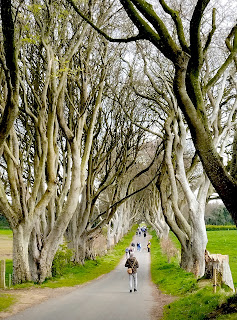April 29th
We met Steve Malone at the entrance gates of Belfast City Hall for A History of Terror tour. We stood out of the rain under the portico at City Hall while Steve provided the historical background to the development of Irish identity since Henry VIII. Of course, Irish history long-precedes the 16th century, but the troubles between the Irish and The English begins when Henry VIII separated from the Catholic Church because Pope Clement VII wouldn't dissolve his marriage to Catherine of Aragon so he could marry Anne Boleyn. We all know the story.
Anyway, we had an unbelievably informative walk around Belfast City Centre, stopping at corners and store fronts where assassinations, IRA bombings, and the cycle of violent action, reaction, vengeance, and revenge took place where many of the victims were innocent citizens. Steve provided detailed historical context peppered with first hand knowledge about what we all call "The Troubles."
It's too complicated to explain here, and even though we were riveted by the information, what Steve really did was highlight what it felt like to live in a police state and with random violence. He spoke passionately but calmly about the intergenerational trauma engendered by violence and propaganda that fueled fear, geographic separation, anchoring yet more prejudice. This cycle was made worse by economic laws that targeted Catholic men where seventy percent of them in the 60's & 70's were unemployed. So, between the historical English minority rule established by the 17th century, and legalized Catholic oppression and discrimination for fear that the outnumbered English protestants might lose their political power in the 20th century, and all of the other factors described earlier, the Northern Ireland was ripe for distrust, prejudice, anger, violence, and retribution.
This was one of those experiences that was just too difficult to encapsulate; you had to be there. So the pictures I've included here are meaningful to us, because we were there, but I couldn't possibly provide captions describing their significance.
 |
| Belfast City Hall |
 |
| Steve Malone, our guide. |
 |
 |
| "Spirit of Belfast" unveiled in 2009 to celebrate the city's steel and ship manufacturing, but most citizens refer to it as "The Pretzel." |
 |
| Catholics wouldn't dare walk this lane after dark. |
 |
| The whiskey store to the left claims to have the largest collection in the world. |
 |
| This street and the corner to the left were scenes where Catholics were routinely kidnapped, tortured, and murdered. Today, these are some of the safest and most inclusive streets. |
 |
| Just loved this sign advertising the Yardbird's food. |
 |
| Just some cool architecture and artsy stuff in this once violent neighborhood. |
 |
 |
| Albert Memorial Clock |
 |
| The Forgotten Troubles Memorial (a must read) |
 |
| This police station was built 25 years after violence against the police ended... |
 |
| ...but notice the thick blast walls and steel gates. Old thinking is difficult to change. |
 |
| Beacon of Hope |


































































